Intuition in Phenomenology of Architecture
Parisa Shoja1
DOI: http://dx.doi.org/10.12944/CWE.10.Special-Issue1.51
The culture of societies makes their architecture and architecture works as the container of human behaviors influences the culture. Among the bases of culture we could refer to cognition of the world and human and the definition of their relations that has caused the formation of spiritual and materialistic culture s the domination of materialistic philosophies after enlighten and emergence of humanism, has led to deep environmental, humanistic and cultural crises with making changes in relation of human and the world during last centuries. In order to escape the situation, theorists have put forward the change of human relation and the world. One of the most influential contemporary intentions in this field is phenomenology that is of long history in the Wes philosophy but it was appeared more coherent by Husserl. For philosophers, phenomenology is a method of explaining the situation directly about the environment and a way for achieving an understanding without any default and prejudgment and a way to escape from scientific, religious, metaphysical and psychological defaults (Moran et al., 2002). This concept is discussed together with intuition in Islamic culture and the theory of science, scientist and known in transcendentalism. In the present paper we attempt to comparatively study these two concepts with mentioning their architectural bases.
Copy the following to cite this article:
Shoja P. Intuition in Phenomenology of Architecture. Special Issue of Curr World Environ 2015;10(Special Issue May 2015). DOI:http://dx.doi.org/10.12944/CWE.10.Special-Issue1.51
Copy the following to cite this URL:
Shoja P. Intuition in Phenomenology of Architecture. Special Issue of Curr World Environ 2015;10(Special Issue May 2015). Available from: http://www.cwejournal.org/?p=9543
Download article (pdf) Citation Manager Publish History
Select type of program for download
| Endnote EndNote format (Mac & Win) | |
| Reference Manager Ris format (Win only) | |
| Procite Ris format (Win only) | |
| Medlars Format | |
| RefWorks Format RefWorks format (Mac & Win) | |
| BibTex Format BibTex format (Mac & Win) |
Article Publishing History
| Received: | 2014-11-01 |
|---|---|
| Accepted: | 2014-12-03 |
Introduction
Art as the most sublime aspect of the culture is the place for highest humanistic values and concepts and artists and architects always have attempted to reflect and symbolize the truth of being in their works. In architecture, the natural place is the starting point of recognizing the structures and meaning of the nature. Because, we could obtain motivation and inspiration for the design by its roots and source, formal structure and concepts and Deformation in site represents architectural designing (Von Meiss et al., 2013).
another way to discover the essence of being is achieving its geometry. Geometry is introduced as a tool for correct thinking and domination factor on nature. Nadimi says, Sensible nature, concealing and phenomenal geometry that decodes the exemplary forms, is the source of intuition for Muslim architect. Having intuition on these codes and learning it with heart and flying in the land of fantasy makes the architect the drawer of truth. The inspiration of mystic architect from nature is inspiration by its concealing drawing that after duplication and diversities it is intuited by the architect ( Nadimi et al., 1999).
The depth of this reflection includes the cognition that could exist from shapes, geometry and perspectives to core of the being. These artists attempted to achieve the last rank of cognition without any error and mistake. The cognition is Interpreted intuition or presence in Islamic culture and Phenomenology in Western philosophy. Intuition includes two methods by Islamic mystics and philosophers: Heart and the Mind.
- Mystic intuition: Intuition include cognition caused by heart through spirit purification and comporting that never could be achieved through experience, emotion, science, intellect, thinking or philosophy. Mystic passes all dark and light roads and opens the unseen through heart vision. This cognition is not of achieving nature or through concepts, but it is intuitional and moral.
- Philosophical intuition: In attendance science there is no conceptual i.e. mental forms or emblematic forms between the man of knowledge and known. The man of knowledge achieves awareness that in sublimity philosophy it means the unity of man of knowledge, science and known.
Intellectual and philosophical intuition is similar to whatever was represented as phenomenology by Husserl. The main bases of phenomenology is paying attention to things itself and paying attention to things necessitates the omission of all information and previous theories about the thing and only the essence of the thing is considered. Phenomenology is identification of nature through intuition.
Methodology
Considering originality for human mind started with the famous sentence by Descartes as “I think, therefore I am” and it caused advance of the science, cognition of natural phenomena with scientific rules and atomistic standpoint. By applying philosophy to the bases of the mathematics and domination over it, an approach appeared that Husserl names it as naturalist thinking. In naturalistic thinking, things and creatures are separate and from human. Human is a separated creature from the world. Naturalism is the main root of losing the directions, getting empty of cultural values and sense of crisis and human collapse. According to naturalistic thinking, only the aspects are considered that pay attention to materialistic life of human. Only through returning to its original meaning, human could release himself from traps of crisis as a meaningful creature and a creature that “is beyond nature fields” and “a creature that could further the wide ranges of possibility.” Therefore, understanding the truth of human is the first and basic way to escape the crisis. Bio-world is an intuitive world. In bio-world the role of the creatures and their meaning is because of living in bio-world and because of their role and meaning they EXIST.
Husserl believes that science is in crisis, in order to pass the crisis, the best method is having certain understanding, paying attention to nature of phenomena. In phenomenological method, Husserl attempts to form a solid base for all sciences especially the philosophy. He finds the main source in intuition or in the primary awareness that is created without mediator. Schultz believes that phenomenology is a method that attempts to achieve the structures and meanings of the life and does not want to replace it with natural science, but tries to make a replacement for all relations, principles and scales. In fact, from his standpoint, scientific approach to thing, separates them from their real bed and considers them as measurable issues ( Shirazi et al., 2010).
Phenomenology is one of the most effective modern philosophies, have influenced the theory and practice of architecture. Architecture phenomenologist considering the abilities of phenomenology in both theory and practice, have considered the basic concerns as the starting point of work and have attempted to give a different architectural understanding about architecture and environment.
Undoubtedly, we could consider Juhani Pallasmaa, one of the most influential theorists in developing phenomenology in architecture. His understanding from phenomenology closes him to Husserl with “pure look at phenomena.” According to Pallasmaa, phenomenological thinking is a deep glance at things that makes us closer to essence of things and keeps them close to us, he writes, I believe that phenomenology is the sublime art of facing the world. Architect in fact must discover and state this basic approach and reports its approach to the world (Shirazi et al., 2010).
He has criticized the Western vision based thinking, extremist standard thinking, extremist avant-garde thinking, visual post modernism, solid philosophical thinking and believes that the domination of vision on architecture has caused us to have incomplete understanding of the environment. Since, according to him, “the experience of case architecture is multi-emotional” (Pallasmaa et al., 1996). The quality of material, space and scale is measured with eye, ear, nose, skin, tongue, body and muscles. Therefore, the image of multi-emotional architecture is created by him. “Architecture of senses” is an architecture that pays attention to presence of all senses. The architecture of senses when is formed with participation of body and all senses, closes us to the things and their essence, vice versa, the visual architecture stand in distance and measures from distance. In other words, he attempts to understand architecture not as a single thing but as in its bed. The idea of circumferential vision is the understanding architectural work in its bed and it is not a physical issue but includes cultural and social aspects either. He writes, “Focused standpoint makes us only a supervisor. Circumferential understanding changed visual images to spatial and anatomic experience and invites us to participation.”
According to Pallasmaa, Alto was an architect that instead of conceptual and form based pureness attempted to make compromise among nature, culture, history and modernity, society and individual, tradition and innovation, standardization and diversity, regional and global issues, logical and sensational issues and finally, logical and intuitional issues. He calls the architecture meta-technical and attempts to offer a humane architecture and using the technology tries to respond the psychological and physical needs of human that Villa Mairea as shown in figure 1, is the crystallization of his ideas and it is designed according to Wright's Falling water house ( Perez et al., 2010).
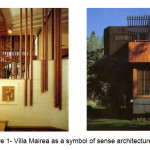 |
Figure1: Villa Mairea as a symbol of sense architecture Click here to View figure |
Theorists and critics such as Bruno Zevi and Schultz having an architectural standpoint, attempts to offer exclusive point of view in architecture. Zevi, Wright, Schultz believe Kan as the symbol for understanding the phenomenology and introduced his architecture as essentialist architecture that is raised out of intuition to existence (Sveiven et al., 2011). Among today's architectures Tadao Ando, the Japanese architecture has given an architecture method according to Zen and Shinto thinking ( Metcalf et al ., 2011) .Therefore, some of his theories believe him as close to interpretation of Heidegger's phenomenology (Noghreh Kar et al., 1998) .
Results
The geometry in Islamic architectural decorations, drawings, stalactite works, arabesques and girihs represent the intuitional understanding of the artists. The geometry of Islamic nodes is similar to structure of crystals in current scientific achievements ( J. Lu et al., 2007) . that briefly we explain them:
Discovering the atomic structure of semi-crystals that are shapes between the glass and crystal with atomic structures, are the important achievements of science. Their atomic structure is ordered but non-continuous but has a circular quintuple symmetry. The first mathematical explanation of it is famous as Penrose order that is developed out of two basic forms as Dart and Kite as shown in Figure 2 (Weisstein et al., 2015).
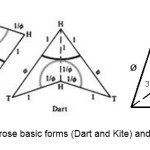 |
Figure2: Penrose basic forms (Dart and Kite) and their geometry Click here to View figure
|
Kite is a square with internal angels of 72, 72, 72 and 144 whose axe divides it to two golden triangles. Dart is another square with internal angles of 36, 36, 72 and 216 whose axe divides it to two golden triangle. The golden triangle is a isosceles that the relation of the leg to base is the same of golden relations and it is of two kinds: a triangle with angles of 36, 72, 72 and another triangle with angles of 108, 36, 36.
In order to develop these basic forms, there are different patterns that one of them drawn arches with two different colors on them in a way that when ordering, the arches of the same color coincide in one point. The naming rule of the angles is as H and T, when ordering, the angles with same name coincides as shown in Figure 3 (Weisstein et al., 2015).
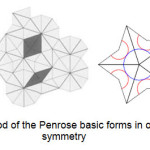 |
Figure3: Ordering method of the Penrose basic forms in order to achieve pentagon symmetry Click here to View figure |
Ordered and non-continuous pattern in Islamic girih could be observed in Iran, India, Uzbekistan, Afghanistan and Turkey. One of famous examples is Jami Mosque of Isfahan. Interesting and miraculous point is that there is a much similarity between the semi-crystals and mentioned nodes and it means that its mathematics was known to Muslims 500 year ago or as some believes, Muslim artists knew it through intuition as shown in Figure 4.
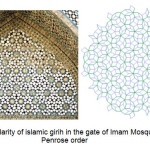 |
Figure4: The similarity of islamic girih in the gate of Imam Mosque in Isfahan with Penrose order Click here to View figure |
Basic shapes of Penrose order, A and B, is considered with blue and red curves and there are arrows in internal part and left side. In order to have correct order and since basic shapes are limited, according to distention rule, we add them to the structure with smaller scale (Shapes in right side of the arrow). Putting the basic shapes of the Penrose besides each other, the basic shapes of Islamic nodes (extended hexagon C, bow tie D and decagon E). the ordering pattern of the left side shape F, in edges that are given as dotted line, have problems and left side shape of F represent ideal and correct pattern as shown in Figure 5 ( J. Lu et al., 2007).
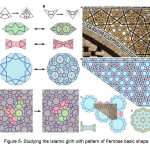 |
Figure5: Studying the Islamic girih with pattern of Penrose basic shape Click here to View figure |
We can perceive resemblance of this stunning geometry to the feeling geometry. Alto believes the architectural experience to be a continuum of influences not as geometrical abstractions and formal combinations. He speaks of the work atmosphere and believes that experiencing the work is based on atmosphere of work. In defining feeling geometry Alto says: “I believe that most people, and of course the artists in an especial way, understand the atmosphere of a work. It is obvious in old architecture. Here we face such a pure happiness that in most cases we do not pay attention to details, if we have paid attention to them ” (Pallasmaa et al.,1996).
The artistic aspect of architecture is not the physical reality of the thing but is individual awareness that is experienced. Therefore, analyses of an artistic work are its real introspection by the knowledge; and its meaning is concealed in samples of the forms and sensational transferred forces not in their forms. Form influences us through the reflection. Architectural language is the language of symbols that could be recognized by our existence. Therefore, they lack any relation with sensational memories in our unconsciousness and senses, it is not art anymore and it degenerates as meaningless decorations. Experience of art, is the product of interaction between our world and our embodied memories. ( Nesbitt et al.,1995)
- From the standpoint of Muslim architects, human must construct and integrate the nature. Accordingly, their architecture is based on intuition of natural places and architecture site. An intuition that includes a wide range of specifications such as climatic, formation, historical, cultural and social specifications (Shodja et al., 2013).
The zoning of cities and buildings, considering their climate, sunshine model, wind blowing direction (suitable wind, storm, tornado, ..) self sufficiency and supplying local material, using module and practice, elements such as windward, central yard, Shwadan, hole, garden … in order to livable microclimates, accordance with general face of the city and respecting the available visual background, introversions and respecting the cultural background, etc. all represents exclusive and intuitional standpoint towards the environment of natural architecture. It could be a translation of this sentence by Vitruvius: “Correcting the nature of site by the art.” as shown in figures 6 & 7.
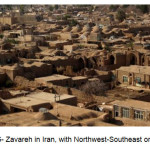 |
Figure6: Zavareh in Iran, with Northwest-Southeast orientation Click here to View figure |
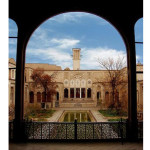 |
Figure7: Brujerdy's house- Kashan Click here to View figure |
Similar to Islamic architectures, from Schultz's standpoint, studying the site must be based on phenomenological methods or poetical, and the natural place must be the starting point of recognizing the structures and meaning of the nature. Deformation in site represents architectural designing as shown in figures 8-11. Since, “this natural site is ruined by our architecture, enforced or deformed, therefore, before designing; we must study its background. Because, we could obtain motivation and inspiration about its roots and source, formal structure and concepts ” (Norberg-Schulz et al., 1963).
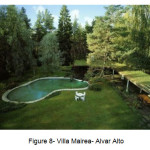 |
Figure8: Villa Mairea- Alvar Alto Click here to View figure |
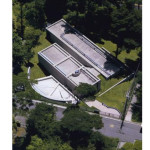 |
Figure9: Koshino house, Tadao Ando |
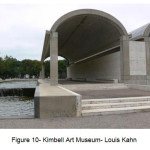 |
Figure10: Kimbell Art Museum- Louis Kahn Click here to View figure |
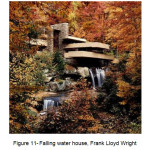 |
Figure11: Falling water house, Frank Lloyd Wright Click here to View figure |
Discussions
The aim of architecture is to reproduce the meaning for world or existence meaning through creating place. In spite of great progresses in technology, materials, new technologies and new intentions in architecture, only some of architectural works have been successful in creation of place, since, in modern vision-based architecture formal structure and harmony, abstract forms and Fractal geometry is emphasized, while these principles are not enough to experience the space and recreate the sensational aspect, so some critiques believe that modern architecture is void in form, since its form is extremely abstract and rational. Phenomenological and intuitional look into the being, created the architecture of senses and location experience as a strategy. A proof for this experience is architecture in Iran that with a humane and intuitional approach has continued for three thousand years. Exiting this current crisis could not be achieved by imitating the forms and deconstruction, but it depends on regeneration of good atmosphere for architectural place.
References
- Lu, Peter. Steinhardt, Paul J. Decagonal and Quasi-Crystalline Tilings in Medieval Islamic Architecture. Retrieved 23 February 2007. from:http://www .sciencemag.org /content/315/5815/ 1106 .figure-only#F3.
- Metcalf, Taylor. AD Classics: Koshino House / Tadao Ando. Retrieved 25 Sep 2011 from: http://www.archdaily.com/161522/ad-classic-koshino-house-tadao-ando/
- Moran, D. and Mooney, T. The Phenomenology Reader (Routledge,2002).
- Nadimi, Hadi. Fact of Figure. Second Bam Congress. April15, kerman (1999).
- Nesbitt, Kate. TheorizingAgenda for ArchitectureAn anthology of architectural theory (Princeton Architectural Press,1995)
- Noghreh Kar, Abdolhamid. Human Being, Nature and Architecture (payam nur, 1998).
- Norberg-Schulz, C. Intentions in Architecture (Allen & Unwin LTD, 1963).
- Pallasmaa, J. The Eyes Of The Skin, Architecture and the Senses (Academy Editions,1996).
- Perez, Adelyn. AD Classics: Fallingwater House / Frank Lloyd Wright. Retrieved 14 May 2010 from: http://www.archdaily.com/60022/ad-classic-falling water-frank-lloyd-wright/
- Shirazi, Mohamad Reza. Phenomenology in practice,Learning from the Pallasmaa Phenomenological analysis of villa mairea. Arman Shahr , 4(11), 125-132 (2010).
- Shirazi, Mohamad Reza. Phenomenology of place. (Rokhdad no, 2010).
- Shodja, Parisa. Masdar, a city of future. Designer, 7(14), 126-132 (2013).
- Von Meiss, Pierre. Elements of Architecture from Form to Place with Comparative Analysis of Iranian Architecture (university of Tehran Press, 2013).
- Sveiven, Megan. AD Classics: Kimbell Art Museum / Louis Kahn. Retrieved 31 Mar 2011 from: http://www.archdaily.com/123761/ad-classic-kimbell-art-museum-louis-kahn/
- Sveiven, Megan. AD Classics: Villa Mairea / Alvar Aalto. Retrieved 28 Oct 2010 from: http://www.archdaily.com/85390/ad-classic-villa-mairea-Alvar-Alto/
- Weisstein, Eric. Penrose Tiles. Retrieved 13 Apr 2015 from: http: //mathworld. Wolframe . com/Penrose Tiles.html.







